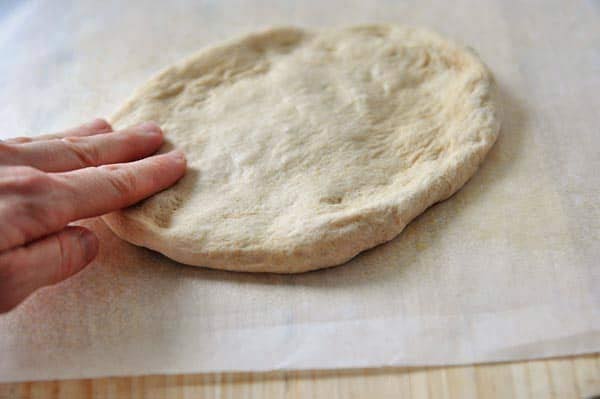What Makes Pizza Dough Chewy?
There are a lot of things that go into making the perfect pizza dough, but one of the most important is getting the right amount of chewiness. This can be achieved by using the right type of flour and adding just enough water to create a soft, yet firm, dough. The key is to not overwork the dough, as this will make it tough.
Once you’ve got your dough made, it’s time to start stretching it out into shape. Again, you don’t want to overdo it or your pizza will end up being tough. Once you’ve got your desired thickness, it’s time to add your toppings and bake!
Pizza dough is chewy for a variety of reasons. The type of flour, the amount of water, and even the way the dough is mixed can all contribute to its chewiness. One reason pizza dough is chewy is because of the type of flour used.
Bread flour, which is higher in gluten than all-purpose flour, will give the dough more structure and make it chewier. If you’re looking for an even chewier crust, you can use 00 flour, which is even higher in gluten than bread flour. Another reason pizza dough is chewy has to do with hydration.
A wetter dough will be more elastic and chewy than a drier one. So, if you want a chewier crust, add a little extra water to your dough recipe. Just be careful not to add too much or your crust will be tough instead of chewy.
Finally, how you mix your pizza dough can also affect its texture. Kneading the dough by hand or with a stand mixer develops the gluten strands that make pizza crust chewy. If you don’t knead your dough enough, it won’t be as elastic and won’t hold together as well when you stretch it out.
Conversely, if you over-knead your dough, it will become tough instead of chewy.
Homemade Pizza Dough Recipe | CRISPY, CHEWY, BUBBLY CRUST
What Makes Pizza Dough Chewy
Pizza dough is chewy because of the gluten in the flour. Gluten is a protein that forms when flour is mixed with water. It’s what gives bread its structure and allows it to rise.
When you knead the dough, you’re stretching and folding the gluten molecules so they can trap air bubbles. That’s why pizza dough becomes more elastic and less sticky as you knead it. The amount of gluten in flour also affects how chewy your dough will be.
Bread flour, which is made from wheat that has a higher protein content, will produce a chewier crust than all-purpose flour. And semolina flour, typically used for pasta, will make an especially tough crust. So if you’re looking for a really chewy pizza, use bread flour or semolina flour.
Another factor that affects chewiness is the amount of moisture in the dough. A wetter dough will be more tender and easier to bite into, while a drier dough will be tougher and have a longer shelf life (which is why many pizzerias make their dough ahead of time). You can adjust the moisture level by adding more or less water to your recipe.
Just keep in mind that too much water will make the dough difficult to work with. Finally, fermentation also plays a role in determining how chewy your pizza crust will be. When yeast ferments sugar in the presence of oxygen, it produces carbon dioxide gas bubbles that expand the gluten network and make the dough lighter and airier (this is what makes bread “rise”).

Why is Pizza Dough Chewy
Pizza dough is chewy for a variety of reasons. The type of flour, the amount of water, the amount of yeast, and even the temperature can all affect the chewiness of pizza dough. Flour: The protein content in flour is what helps to form gluten, which in turn makes dough chewy.
All-purpose flour typically has a protein content of 10-12%. Bread flour has a higher protein content, usually around 12-14%. For an even chewier crust, you could use a bread flour with a higher protein content.
Water: Too much water will make dough sticky and difficult to work with. Not enough water will make it crumbly and dry. The ideal moisture content for pizza dough is around 45-55%.
Yeast: Yeast helps to add flavor and texture to pizza dough. It also allows the dough to rise, which gives it a more airy and light texture. Too much yeast will make the crust taste too yeasty or “raw” tasting.
Not enough yeast will result in a less flavorful crust that may not rise as much. The ideal amount of yeast for pizza dough is between 0.25% and 2% (by weight). Temperature: Warmer temperatures will cause the ingredients in pizza dough to activate faster, resulting in a quicker rise time.
This can cause the crust to be thinner and less chewy.
How Can I Make My Pizza Dough Less Chewy
If you’re looking for a less chewy pizza dough, there are a few things you can do. First, you can add more water to the dough. This will make the dough more hydrated and less dense, which will result in a less chewy texture.
You can also add more flour to the dough, which will make it drier and less sticky. This will also result in a less chewy texture. Finally, you can add more oil to the dough, which will make it smoother and less elastic.
This will also result in a less chewy texture.
Conclusion
What Makes Pizza Dough Chewy? Pizza dough is made from flour, water, yeast and salt. The key to making it chewy is to use bread flour, which has a higher protein content than all-purpose flour.
The proteins in the flour form gluten when they come into contact with water. Gluten is what gives bread its elasticity and chewiness.







